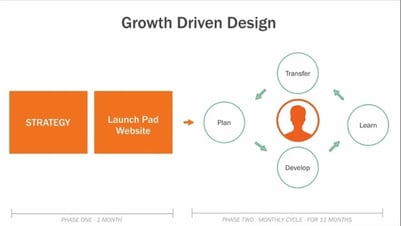Most companies realize that in order to stay abreast with advances in website technology, graphics and social culture, it is important to make changes to their website periodically. These changes aren't the small tweaks or additions of new product pages, instead wholesale website overhauls.
The traditional method of changing your website is for your marketing department to decide on the fact that a new website is needed, then your executive team budgeting for the expense. After those steps, a website developer is chosen and the project is handed off until the new site is completed and installed. While the order of making the decision may change, and your marketing department may be more involved in the development of the site, this process is typical.
What is the Difference with Growth Driven Design (GDD)?
Growth driven design offers an in-depth approach to creating a new website. The process provides your company with not only a new site that should work providing all of the traffic, marketing lures and other improvements that you are looking for, but takes it one step further. When you are offered growth driven design, your website developer will continue to work with you to make changes and improvements that ensure that it works.
The concept is more than providing you with an attractive website that includes your branding and other marketing requirements. Instead, it is an ongoing partnership between your company and your website developer in turning your website into an effective, user-friendly marketing tool.
What Services Does GDD Provide?

A website company that provides you with GDD for your new site offers much more than a website. They become marketing consultants by providing the following:
- Ongoing design improvements
- Ongoing audience research to provide data for the design improvements
- Dynamic branding
- Turning your site into an efficient marketing asset
GDD is a combination of website development and many of the research-driven tools available to drive traffic and conversions. Your company and the developer become partners in your company's success. While they still remain a vendor/contractor, their success is completely dependent on your success. If your site does not perform properly, then they are there to find out why and improve it. If it is performing, then they will do research and testing to make it even better.
Drawbacks to GDD
The biggest and only real drawback to GDD is that it is more expensive upfront than a traditional website. The price for hiring a company to become an ongoing partner is higher than for a one-time vendor. It is sort of like buying a house. When you buy a house, you make a down payment to the bank, and then make mortgage payments until the entire home is paid for. In the case of GDD, you hire a firm on a retainer. You make an initial payment to start working on the website, and then pay them in installments throughout the year. The service is more than buying a website, so you are paying for more.
What You Get in Return for Your Investment
Like buying a home, GDD is an investment. You are making an investment into the future marketing and success of your website. Your developer is not just creating a site for you and maintaining the programming for you. They are creating a site that will generate leads and sales, increase your income and profits and they are keeping it profitable as time goes on. They are maintaining the programming, improving its effectiveness as a marketing tool and fine-tuning it to continue to generate growth. Like most purchases, the bottom line is your ROI. And unless your company has an in-house website marketing guru, your ROI will by far pay for the investment you make.




